SURVIVAL IN THE ARCTIC
Collection of drinking water in arctic conditions
Once in the Arctic, you can hardly find fuel and food, but you can be sure that you will not suffer from thirst. When water in the form of snow or ice is abundant around you, you are not in danger of dehydration. These water sources are generally clean. However, eating snow or ice increases the risk of hypothermia – a major problem in arctic conditions. When consumed cold, the temperature of the throat, neck, and therefore the whole body decreases. A large supply of warm blood is continuously pumped through the arteries, which enters the brain, and then through the jugular vein again enters the heart. Therefore, it is especially important not to overcool the neck.
While boiling is the safest option for water purification, fresh snow and ice collected from locations where there is no standing water or other visible sources of contamination can be consumed with little concern.
Most bacteria found in water do not survive freezing temperatures.
Prefer ice over snow whenever possible. It has a higher density of the contained liquid. In arctic conditions, fuel is a precious resource, and therefore, if possible, use your body heat to obtain drinking water from ice. If you are dressed in multiple layers, your body will generate a tremendous amount of heat as you move, no matter how cold it is around you.
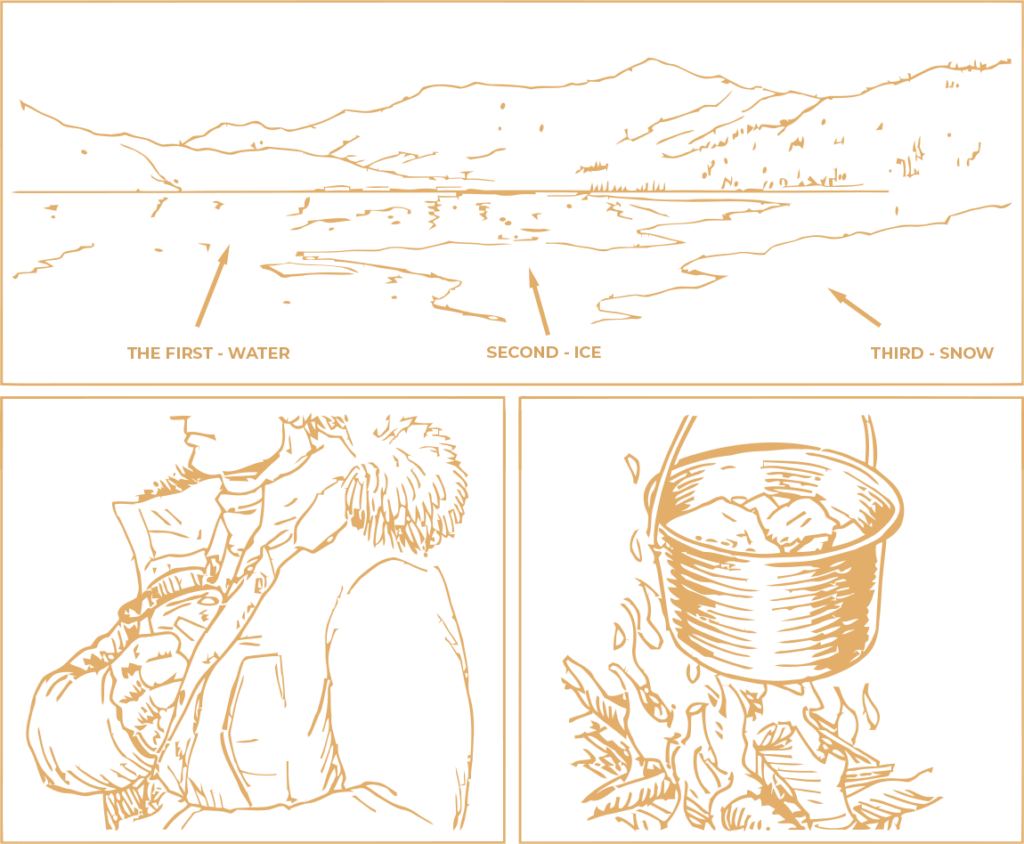
To melt ice, do not apply it to the places where the brachial arteries pass through the armpits and on the femoral arteries on the inner thighs, as these are the most important parts of the body’s blood supply system. Place ice in a water bottle. Place this bottle between the layers of your clothing. When you stop, take care of your body heat and continue melting the ice on the fire.
Lighting fire in arctic conditions
When everything is covered with snow and ice, finding the materials with which to start a fire becomes a very difficult task. However, given the importance of the heat source in subzero temperatures, the effort to collect the ignition ultimately pays off. Despite the desolate appearance, the arctic environment can be quite rich in plants – alive, but hidden from view, or already dead. If you camp near trees, you will most likely find fallen branches and dry ground cover under the snow. Of course, you may not be able to find valuable materials for kindling as soon as you clear the snow to the ground, but they will most likely be found at a very small distance from this place. Clear the outer layer of icy or snowy bark and underneath you will find dry, usable tinder. You may have to spend quite a lot of time looking for it, but in some circumstances, this effort can save your life.
Collected the necessary material for kindling, you can use any available batteries to generate a spark. Use a metal washcloth for field washing to connect the battery terminals.
When the electrons generated by the battery pass through the thin wire, a lot of heat is released, and the structure of such a sponge in the form of a cocoon with a large number of air pockets located between its threads intertwined with each other creates an ideal environment for ignition.
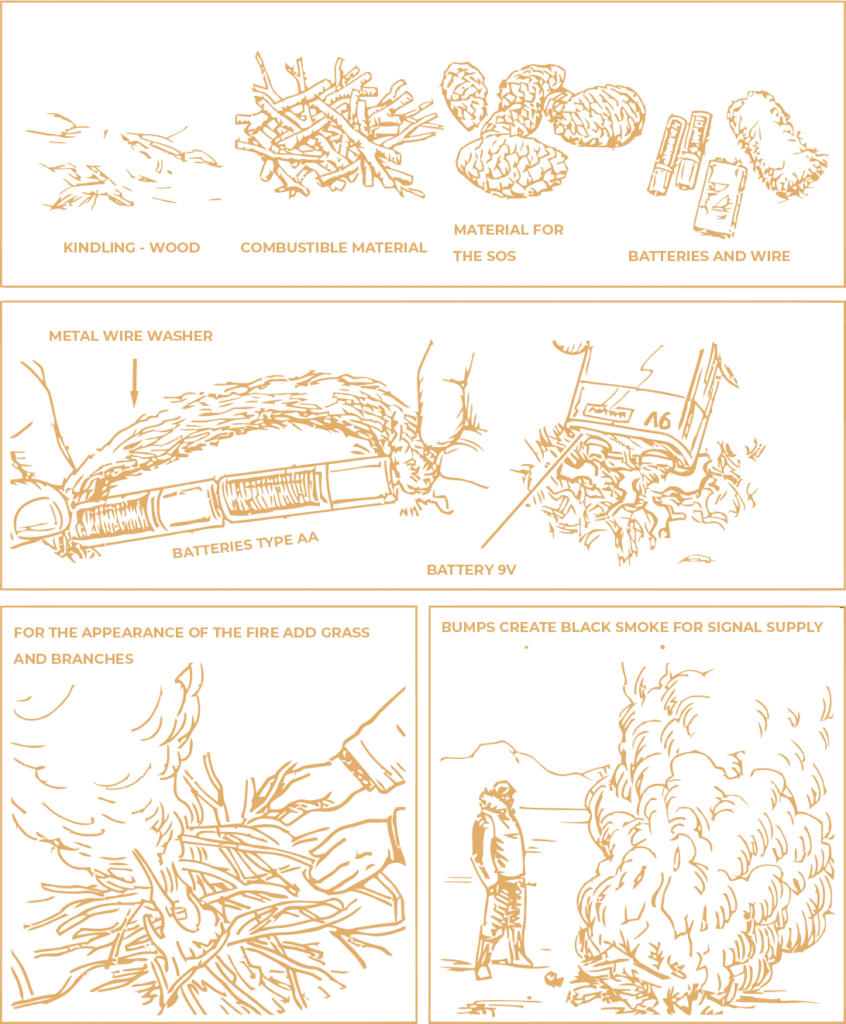
To assemble the necessary structure, connect two AA or AAA batteries with their ends so that the positive terminal is in contact with the negative (anode with cathode), and press the ends of a metal sponge to the outer ends of these batteries. You can do it even easier: tuck one 9V battery inside the washcloth. Keep your fingers away from the contact points and be ready to slip a coil of wire under your kindling. The metal will quickly turn red under the influence of the current, and smoke will go.
If you need to send a signal in the form of black smoke, which is clearly visible against the background of the overall whiteness, add resinous pine cones to a well-ignited fire.
Foraging for survival in subzero temperatures
The most important thing to survive in arctic conditions is to maintain body temperature. For this, the body is ready to “donate” fat cells, fingers and toes, and consciousness will work to a minimum. Under these conditions, any food is processed almost twice as fast as usual.
Maintaining a body temperature that is 50 degrees or more above the ambient temperature is a difficult task. In addition, during the transitions, you have to overcome snowdrifts about 30 cm high, and for this you need to be strong.
The optimal number of calories for the body to function at full capacity in low temperature conditions is 5,000.
Focus on the coastline. Although may seem like there is nothing edible to survive in the snowy wilderness, the shores of Arctic lakes and rivers are often home to nutrient-rich creatures such as mussels and shellfish that can be safely eaten raw or used as bait. Make fishing holes. Getting enough fat to keep your body alive is not an easy task. Of course, you shouldn’t go into icy water to find fatty fish there. However, if the lakes or river beds are frozen, you can use an ice saw to make fishing holes.
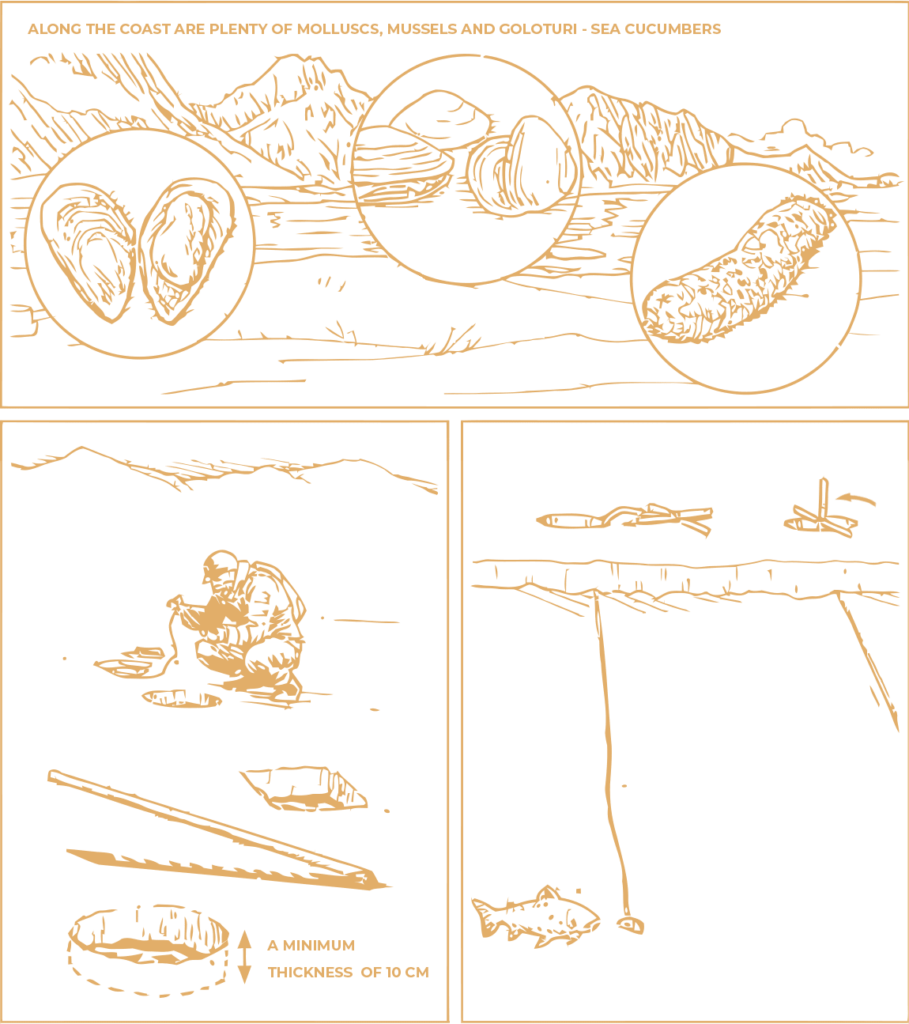
First you need to make sure that the thickness of the ice cover is at least 10 cm. Before going out on the surface of the frozen water, check with a knife if the ice is not too thin. Set up some fishing lines and keep an eye on them. To increase the chances of catching fish, make several holes, lower the fishing lines in them and watch them using floats made from available materials. Tie fishing lines to a pair of sticks that are longer than the diameter of the holes you made, and place those sticks on top of each other in the form of the letter X. When the fish bites, the sticks will move over the hole.
Create shelters suitable for arctic conditions
If you are forced to take a vacation in the wild, consider yourself very lucky if you find a natural shelter – it will save a lot of time. Caves, rocky formations, or even trees with dense foliage or hollow root systems can serve as a refuge for the night or a place to ride out the storm. Care must be taken when choosing, though: a place that you find an excellent hiding place can be just as attractive to wild animals. Before setting up your camp, look for footprints, faeces, and trampled vegetation nearby. If a polar bear or other predator lived before in a convenient place you found, then they can return.
Isolate your chosen hideout as much as possible. To do this, sprinkle as many branches around as possible, cover the floor and walls with them, and in the place where you make the entrance, build a kind of barricade.
In a well-insulated shelter, your body heat alone can raise the temperature by 10–20 degrees.
When it comes to building a shelter in arctic conditions, you can, paradoxically as it may sound, take advantage of the properties of snow and ice. The snow shelter traps body heat and protects from outside cold. Due to its looseness, i.e. high air content, snow is not considered the best source of water, but it serves as a building material with good insulating properties.
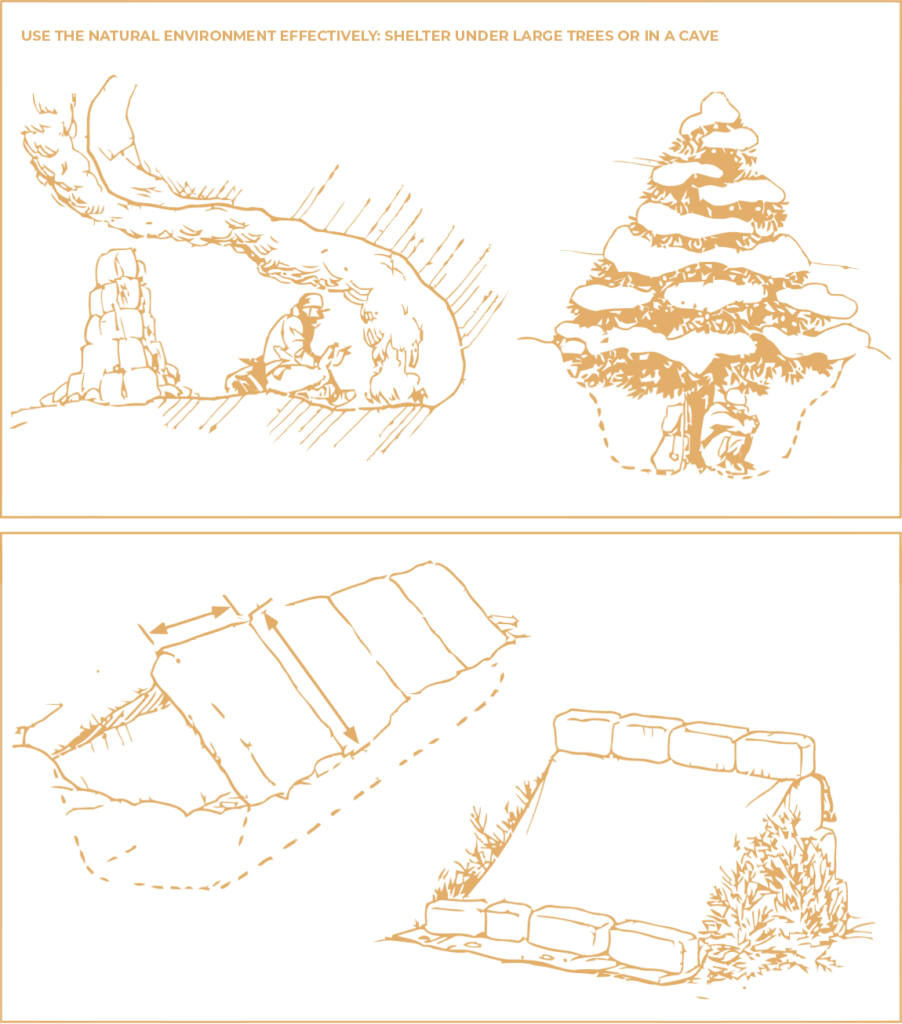
The quickest way to build a snow shelter is to dig a hole under the low-hanging branches of a tree. While burying in a deep snowdrift may seem like a tempting idea, with this option there is a possibility of collapse and should therefore be avoided.
If there is no natural shelter nearby, in an hour or two, using a snow saw and a shovel, you can build a shelter in the snow in the form of a trench. When building trench shelters or using a cape, orient them so that it was perpendicular to the direction of the wind, so that cold air will not pass through them.
Avoiding hypothermia
Signs of hypothermia include tremors, a fluctuating resting heart rate, and mild confusion in the head. The danger increases when the shaking stops and the heart rate declines. Your normal temperature drops sharply, which indicates a slowdown in chemical reactions in your body, and this can lead to death.
No specific external temperature, at which hypothermia necessarily occurs, has not been established. It all depends on the wind, the insulating properties of the clothing, the level of fluid in the body, the degree of physical fitness, the percentage of body fat and the strength of the exposure to moisture.
Water is an excellent conductor of heat. Moisture on or even near the skin will conduct heat away from the body.
If symptoms of hypothermia occur, immediately put on additional clothing or remove wet and put on dry clothing. Avoid lying on cold ground, make a bed of vegetation or other available materials. If you have thermal packs or other heat sources, place them under your arms, on your neck, or in your groin where the arteries pass.
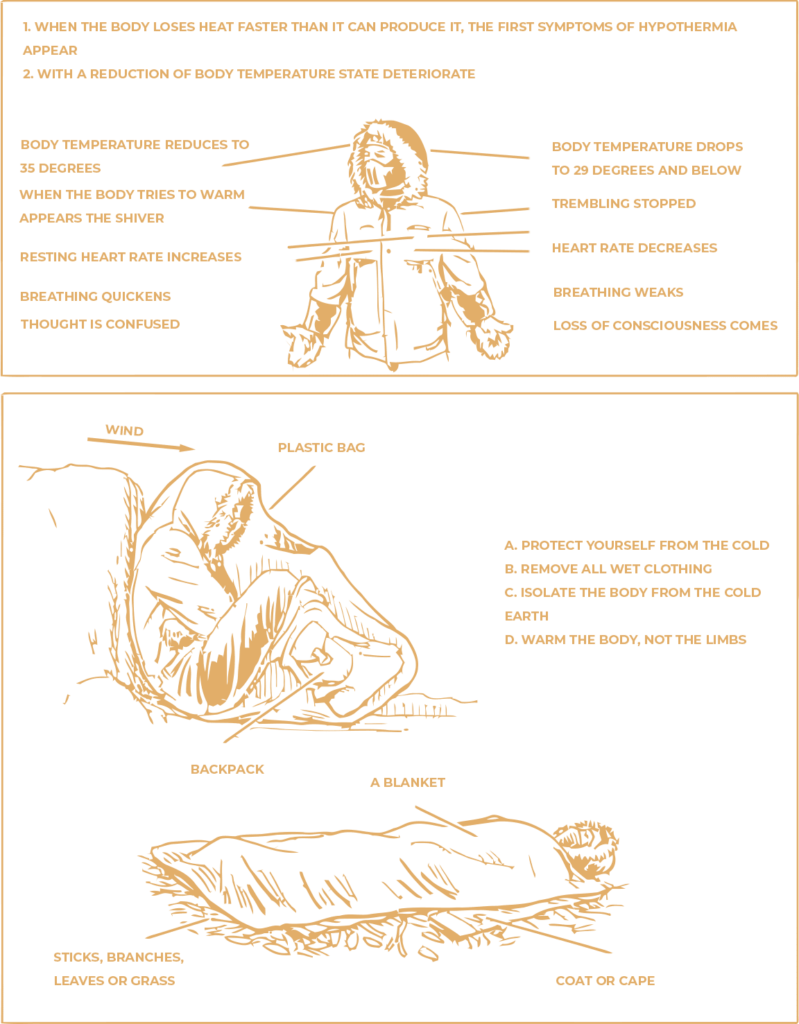
Do not warm your hands and feet until your body temperature has recovered. This will cause increased blood flow to the heart, which can lead to cardiac arrest. The body, in order to conserve resources for basic functions, “sacrifices” the limbs, limiting the blood flow to them.
Avoid alcohol, caffeine, and nicotine, which cause blood vessels to dilate, increasing heat loss.
In a more severe form of hypothermia, urgent help from another person is required – the introduction of an aqueous solution of sugar, mouth-to-mouth breathing, or initial resuscitation in the field help.






